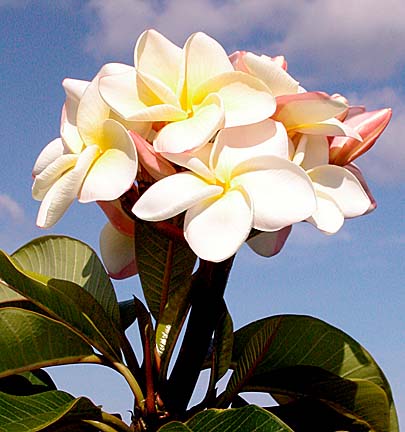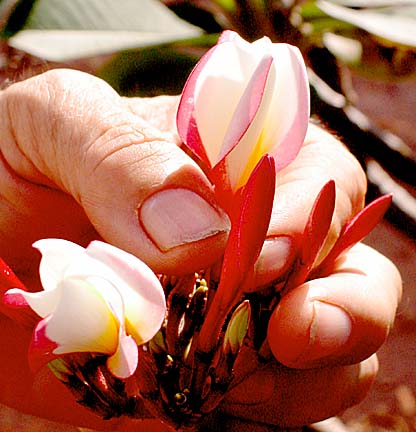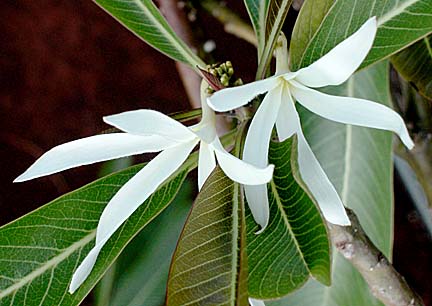


Home & Garden![]()

|
Plumeria power
Outside Hawaii, the heady
flower is now hot -- a boost
to local breeder Jim LittleDesert rose gains popularity indoors
"After all, we live in one of those parts of the world where plumerias do so beautifully. It just makes no sense whatsoever that people wouldn't wear fresh plumerias when we are surrounded by them, and so many different kinds," Little says.
Little made a living as a photography teacher, but he has been an advocate of the humble plumeria for some 30 years. He has been cultivating and hybridizing plumeria, establishing a reputation world wide for collecting the tropical plant and creating new variations.
Little will be sharing his know-how in a workshop sponsored by Honolulu Botanical Gardens April 20. The workshop, from 8 to 10 a.m., will be held at the city's Koko Crater Botanical Garden, which has a collection of more than 80 plumeria trees.

|
Students will learn about cultivation, propagation and hybridizing plumeria and tour the garden for examples of the many varieties of plumerias. Bring bottled water, sun screen, a hat or umbrella for sun protection.Cost is $10 in advance or $15 on the day of the workshop. Call 522-7063 or 522-7064.
"For so long we just took plumeria for granted, and that's too bad; it's a wonderful plant," Little says. The common yellow type has been associated with death and sad events because it is regularly spotted in graveyards. Although the fragrant flowers have been popular lei material, the plumeria fell out of favor as other tropical flowers become more fashionable.
BUT THAT'S ALL changing. Plumeria is all the rage -- elsewhere in the world, where it is sometimes called frangipani. A Canadian television crew recently shot 13 hours of footage with Little for a program on plumeria. He has been invited to Asia on numerous visits to teach horticulturists his refined hybridizing techniques.

|
"It's funny that people elsewhere are so crazy for plumeria, and in Hawaii we don't seem to care much about it. On the mainland, if they get one flower -- just one little flower -- on a tree, they are so thrilled they shoot 10 rolls of film," Little says.In Hawaii, the plumeria is slowing gaining respect as more exotic varieties are introduced. Visitors also prefer fragrant leis over dendrobium orchid leis, Little says.
Now retired from teaching, Little has expanded his operations to include a new farm on the North Shore. His plumeria cuttings are sold through nurseries on the mainland and are also available at Koolau Farmers in Kaneohe and Kailua.
Little continues to collect exotic varieties from Asia, Mexico, South America and other sources. Every year, he produces hundreds of new experiments as he searches for the ultimate plumeria flower -- one with vibrant color, graceful form, durability and sweet fragrance.

|
"Personally I go for the fragrance, that's what I love the most. But I also want a nice, bright color and combinations of colors," Little says."Not all plumerias are alike, and I am always looking for the one that is different," Little says.
OUT OF HIS HUNDREDS of experiments, he discards almost all except for a few that meet his high standards. One of his successful hybrids is a rounded plumeria that resembles a pansy. The flower is white with a bright pink edging on the front. The back of the flower also has a reddish marking along the rims of the petals.
Vera Cruz Rose, a plant collected from Mexico, is one of his favorites. The flower has a rose scent and is a deep pink, and offers potential for unusual hybrids.
"Not all plumerias are alike. The flowers aren't the same, the leaves are different and the growth habits are different. I am always looking for the one that is different, but just because it's different it doesn't mean it's good," Little says.

|
The challenge in hybridizing plumeria isn't necessarily in mastering the difficult pollinating techniques (which requires picking the right flowers and dissecting them) but in producing a new plant with all the desirable characteristics.Little set his heart on creating an incomparable new plumeria flower to be named after his wife, Doric. That has been a goal since he began growing plumerias while teaching at Punahou School in the early 1970s. He is still searching for the perfect flower.
"I've come pretty close a few times. When I get a new flower, I always think this is it, but I always want to wait to see the next crop, to see if there's one that's better.
"Last year I had this killer salmon pink one. It's just gorgeous. I was really watering at the mouth, and I thought that's the one. But ... well, my wife will have to wait."
In the meanwhile, Little is working on creating two more perfect plumerias that he can name after his long-time collaborator, University of Hawaii professor Richard Criley, and Hawaiian educator Gladys Brandt, a family friend.
Place: Koko Crater Botanical Garden Plumeria workshop
by Jim LittleTime: 8 to 10 a.m. April 20
Cost: $10 for advance registration, $15 on day of workshop
Call: 522-7063 or 522-7064
Note: Bring bottled water, sun screen, a hat or umbrella for sun protection
BACK TO TOP
|
Desert rose gains
popularity indoors
By Suzanne Tswei
stswei@starbulletin.comAt first glance the desert rose doesn't look anything like its cousin the plumeria. But they both belong to the Apocynaceae family and thrive in warm, sunny climates.
While plumeria has been an outdoor staple in Hawaii, the desert rose is becoming a favorite potted plant that adds splashes of vibrant colors indoors when it is in bloom. The desert rose produces trumpet-shape flowers noted for their vibrant colors of pink, salmon, red and purple. They also come in white, and newer neon colors and multicolored varieties are being created through hybridization.
Both plants have the ability to survive through dry seasons by storing water in their thick trunks and swollen roots. The desert rose may develop contorted and twisted roots, and bonsai enthusiasts have taken advantage of this nature to further manipulate the trunks and roots to form unusual shapes.
With its thick buttressed and contorted trunks and roots, the desert rose often sheds its leaves as vibrantly colored flowers appear, creating a stunning bonsai plant.
Desert rose as well as other plants will be offered for sale at the Cactus and Succulent Society of Hawaii's adenium show April 20 at Ward Warehouse. Plant culture demonstrations will be held throughout the sale, from 9 a.m. to 4 p.m. Call 522-7063 for more information.
Gardening Calendar
Suzanne Tswei's gardening column runs Fridays in Today.
You can write her at the Star-Bulletin,
500 Ala Moana, Suite 7-210, Honolulu, HI, 96813
or email stswei@starbulletin.com